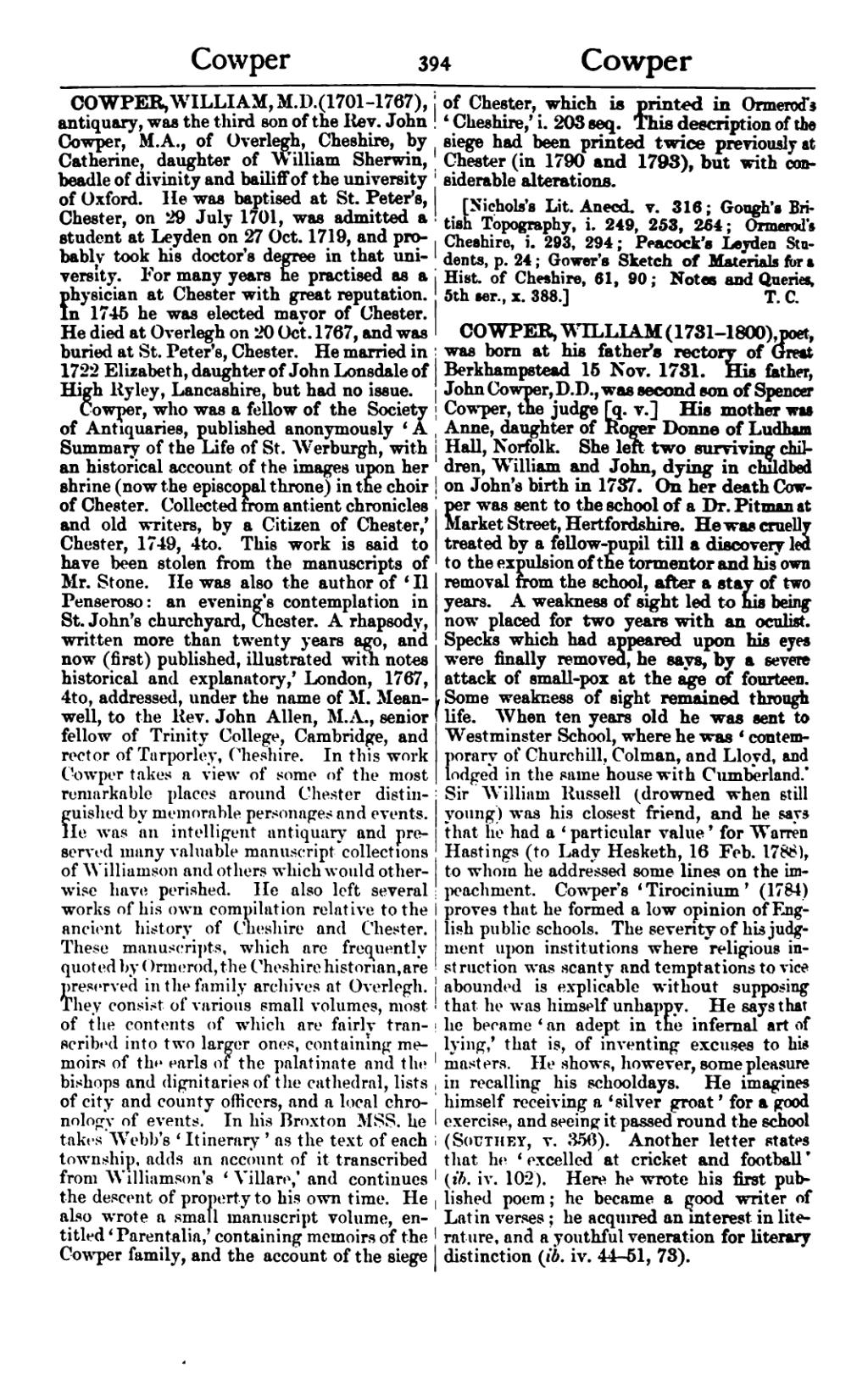COWPER, WILLIAM, M.D. (1701–1767), antiquary, was the third son of the Rev. John Cowper, M.A., of Overlegh, Cheshire, by Catherine, daughter of William Sherwin, beadle of divinity and bailiff of the university of Oxford. He was baptised at St. Peter's, Chester, on 29 July 1701, was admitted a student at Leyden on 27 Oct. 1719, and probably took his doctor's degree in that university. For many years he practised as a physician at Chester with great reputation. In 1745 he was elected mayor of Chester. He died at Overlegh on 20 Oct. 1767, and was buried at St. Peter's, Chester. He married in 1722 Elizabeth, daughter of John Lonsdale of High Ryley, Lancashire, but had no issue.
Cowper, who was a fellow of the Society of Antiquaries, published anonymously ‘A Summary of the Life of St. Werburgh, with an historical account of the images upon her shrine (now the episcopal throne) in the choir of Chester. Collected from antient chronicles and old writers, by a Citizen of Chester,’ Chester, 1749, 4to. This work is said to have been stolen from the manuscripts of Mr. Stone. He was also the author of ‘Il Penseroso: an evening's contemplation in St. John's churchyard, Chester. A rhapsody, written more than twenty years ago, and now (first) published, illustrated with notes historical and explanatory,’ London, 1767, 4to, addressed, under the name of M. Meanwell, to the Rev. John Allen, M.A., senior fellow of Trinity College, Cambridge, and rector of Tarporley, Cheshire. In this work Cowper takes a view of some of the most remarkable places around Chester distinguished by memorable personages and events. He was an intelligent antiquary and preserved many valuable manuscript collections of Williamson and others which would otherwise have perished. He also left several works of his own compilation relative to the ancient history of Cheshire and Chester. These manuscripts, which are frequently quoted by Ormerod, the Cheshire historian, are preserved in the family archives at Overlegh. They consist of various small volumes, most of the contents of which are fairly transcribed into two larger ones, containing memoirs of the earls of the palatinate and the bishops and dignitaries of the cathedral, lists of city and county officers, and a local chronology of events. In his Broxton MSS. he takes Webb's ‘Itinerary’ as the text of each township, adds an account of it transcribed from Williamson's ‘Villare,’ and continues the descent of property to his own time. He also wrote a small manuscript volume, entitled ‘Parentalia,’ containing memoirs of the Cowper family, and the account of the siege of Chester, which is printed in Ormerod's ‘Cheshire,’ i. 203 seq. This description of the siege had been printed twice previously at Chester (in 1790 and 1793), but with considerable alterations.
[Nichols's Lit. Anecd. v. 316; Gough's British Topography, i. 249, 253, 264; Ormerod's Cheshire, i. 293, 294; Peacock's Leyden Students, p. 24; Gower's Sketch of Materials for a Hist. of Cheshire, 61, 90; Notes and Queries, 5th ser., x. 388.]
COWPER, WILLIAM (1731–1800), poet, was born at his father's rectory of Great Berkhampstead 15 Nov. 1731. His father, John Cowper, D.D., was second son of Spencer Cowper, the judge [q. v.] His mother was Anne, daughter of Roger Donne of Ludham Hall, Norfolk. She left two surviving children, William and John, dying in childbed on John's birth in 1737. On her death Cowper was sent to the school of a Dr. Pitman at Market Street, Hertfordshire. He was cruelly treated by a fellow-pupil till a discovery led to the expulsion of the tormentor and his own removal from the school, after a stay of two years. A weakness of sight led to his being now placed for two years with an oculist. Specks which had appeared upon his eyes were finally removed, he says, by a severe attack of small-pox at the age of fourteen. Some weakness of sight remained through life. When ten years old he was sent to Westminster School, where he was ‘contemporary of Churchill, Colman, and Lloyd, and lodged in the same house with Cumberland.’ Sir William Russell (drowned when still young) was his closest friend, and he says that he had a ‘particular value’ for Warren Hastings (to Lady Hesketh, 16 Feb. 1788), to whom he addressed some lines on the impeachment. Cowper's ‘Tirocinium’ (1784) proves that he formed a low opinion of English public schools. The severity of his judgment upon institutions where religious instruction was scanty and temptations to vice abounded is explicable without supposing that he was himself unhappy. He says that he became ‘an adept in the infernal art of lying,’ that is, of inventing excuses to his masters. He shows, however, some pleasure in recalling his schooldays. He imagines himself receiving a ‘silver groat’ for a good exercise, and seeing it passed round the school (Southey, v. 356). Another letter states that he ‘excelled at cricket and football’ (ib. iv. 102). Here he wrote his first published poem; he became a good writer of Latin verses; he acquired an interest in literature, and a youthful veneration for literary distinction (ib. iv. 44–51, 73).
